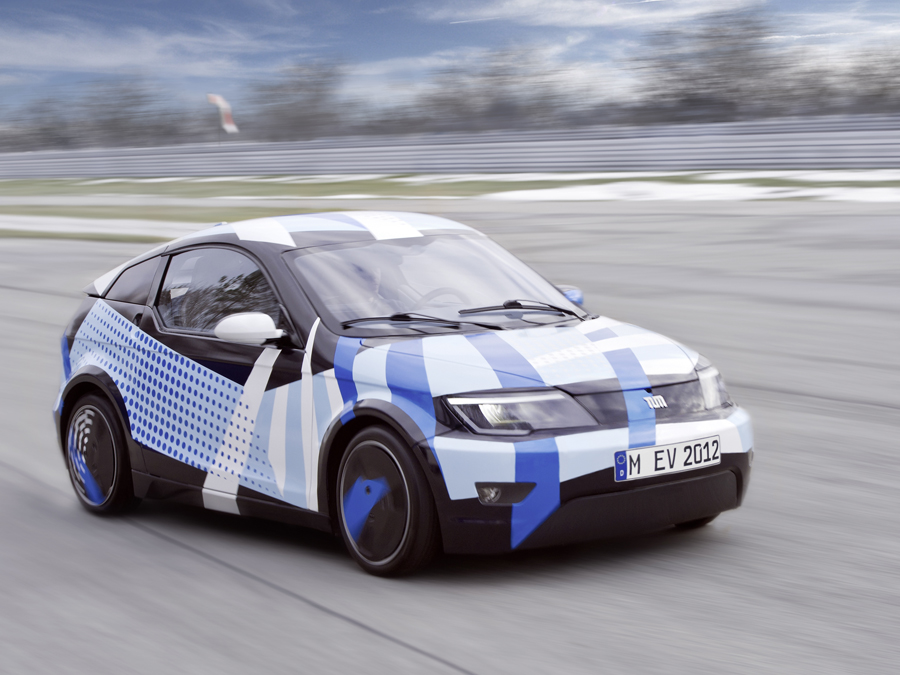Visio.M project: Carbon fiber lightweight design for electric car
Light yet safe contender for city streets

Up to now, it has been a case of “either/or.” On the one hand, we have the typical ultra-compact, lightweight electric car, where designers have had to compromise on safety. With larger e-cars on the other hand, the heavier frames and crumple zones come at the expense of battery range. But now researchers as well as engineers from some of Germany’s top technology firms are looking to create the best of both worlds. The aim of the Visio.M project is to develop a mobility concept for an efficient electric vehicle, making the design as light as possible while still delivering the best possible safety protection.
The Visio.M engineers decided in favor of an innovative monocoque body structure. Typically used in racing cars, a monocoque chassis combined with lightweight materials enables good stability while keeping overall weight to a minimum.
Innovative materials
The developers are also breaking new ground in their choice of ultra-lightweight materials for the structure: The passenger compartment will be made of carbon-fiber-reinforced plastic. Composite materials of this type are already used in the manufacture of aircraft and luxury sports cars. The downside is that they are extremely complex to produce and expensive as a result. So the Visio.M engineers intend to investigate the feasibility of carbon fiber materials in ultra-compact cars suitable for series production.
For the drive system, too, the Visio.M developers are looking to keep weight to an absolute minimum. The e-car they are designing will have an efficient and compact asynchronous electric engine. The transmission system will incorporate very light gears resting on hollow shafts. This would make the gears up to 15 percent lighter than conventional designs.
Safety first
The lightweight design innovations may be impressive, but driver and passenger safety is still the number one priority of the Visio.M project. The sturdy carbon fiber structure will incorporate various dedicated active and passive features addressing the specific safety challenges of an ultra-compact electric car. The ideas being investigated include specially adapted seatbelts as well as other innovative concepts to minimize potential injuries in the event of an accident. By the end of the project, the researchers hope that they will have achieved the maximum possible level of safety.
A research prototype vehicle has already passed some initial chassis tests. The Electronic Stability Program, i.e., the anti-lock braking system and the torque vectoring system, have been put through their paces at a test site near Munich – marking another successful step in the move to develop a safe electric vehicle.
About Visio.M
Participants in the Visio.M consortium are, in addition to the automotive companies BMW AG (lead manager) and Daimler AG, the Technische Universität München as a scientific partner, and Autoliv BV & Co. KG, the Federal Highway Research Institute (BAST), Continental Automotive GmbH, E.ON AG, Finepower GmbH, Hyve AG, IAV GmbH, InnoZ GmbH, Intermap Technologies GmbH, LION Smart GmbH, Neumayer Tekfor Holding GmbH, Siemens AG, Texas Instruments Germany GmbH and TÜV SÜD AG as industrial partners. The project is funded, with 10.8 million euros over two and a half years, within the framework of the program IKT 2020 and the research focus area "Key Technologies for Electromobility – STROM" of the German Federal Ministry of Education and Research (BMBF).
www.visiom-automobile.de
Contact:
Undine Ziller
Media Relations Officer
Technische Universität München
T: +49 (0)89 289 22731
E: ziller@zv.tum.de
W: www.tum.de
Technical University of Munich
Corporate Communications Center
- Undine Ziller
- ziller@zv.tum.de
- presse@tum.de
- Teamwebsite